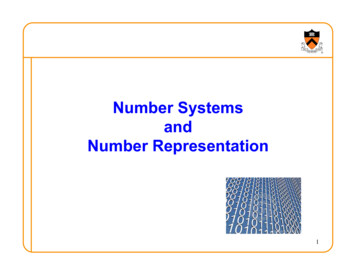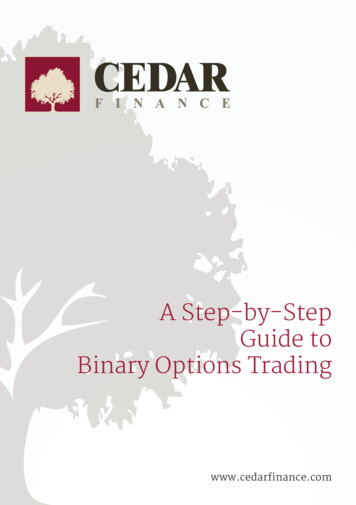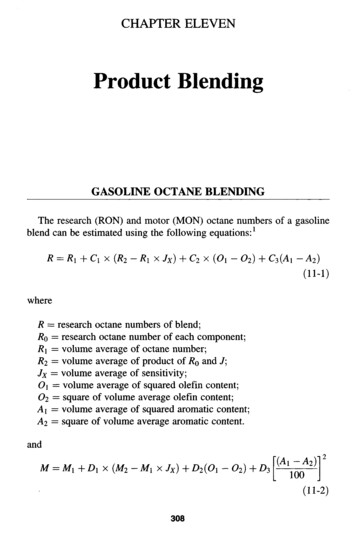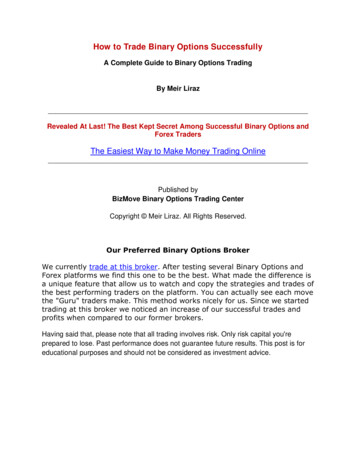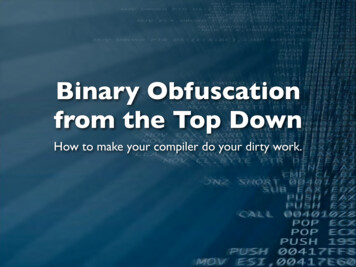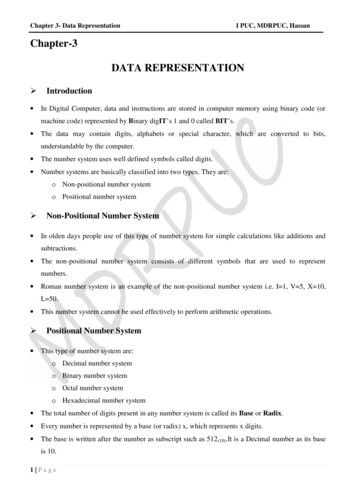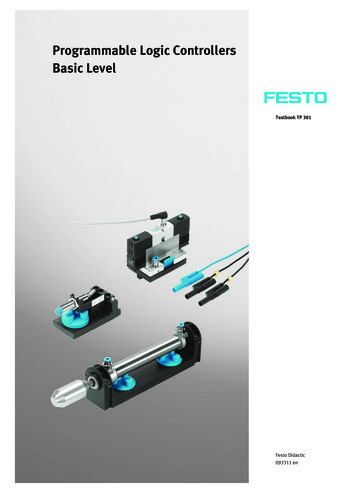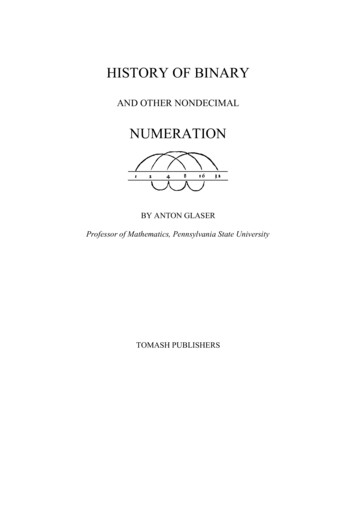
Transcription
HISTORY OF BINARYAND OTHER NONDECIMALNUMERATIONBY ANTON GLASERProfessor of Mathematics, Pennsylvania State UniversityTOMASH PUBLISHERS
Copyright 1971 by Anton GlaserRevised Edition, Copyright 1981 by Anton GlaserAll rights reservedPrinted in the United States of AmericaLibrary of Congress Cataloging in Publication DataGlaser, Anton, 1924History of binary and other nondecimal numeration.Based on the author's thesis (Ph. D. — Temple University),presented under the title: History of modern numeration systems.Bibliography: p. 193Includes Index.1. Numeration — History. I. TitleQA141.2.G551981 513'.5 81-51176ISBN 0-938228-00-5AACR2
To My Wife, Ruth
ACKNOWLEDGMENTSTHIS BOOK is based on the author’s doctoral dissertation, History ofModern Numeration Systems, written under the guidance ofMorton Alpren, Sara A. Rhue, and Leon Steinberg of TempleUniversity in Philadelphia, Pa.Extensive help was received from the libraries of the Academyof the New Church (Bryn Athyn, Pa.), the AmericanPhilosophical Society, Pennsylvania State University, TempleUniversity, the University of Michigan, and the University ofPennsylvania. The photograph of Figure 7 was made available bythe New York Public Library; the library of the University ofPennsylvania is the source of the photographs in Figures 2 and 6.The author is indebted to Harold Hanes, Joseph E. Hofmann,Donald E. Knuth, and Brian J. Winkel, who were kind enough tocommunicate their comments about the strengths and weaknessesof the original edition. The present revised edition is the better forit. A special thanks is also owed to John Wagner for his carefuleditorial work and to Adele Clark for her thorough preparation ofthe Index.
CONTENTSPAGEFOREWORDxiiiI.INTRODUCTION3II.BEFORE LEIBNIZ11Thomas Hariot, Simon Stevin, Francis Bacon, Claude-GasparBachet, Blaise Pascal, Juan Caramuel y Lobkowitz, ErhardWeigel, Joshua Jordaine’s Duodecimal Arithmetick (1687),Weigel’s Philosophia Mathematica (1693)III.LEIBNIZ31Letter to the Duke (1697), Two letters to Johann ChristianSchulenburg (1698), Correspondence (1701) with eArithmétique” by Fontenelle (1703), Thomas Fantet deLagny, Correspondence (1704 – 5) with Jacques Bernoulli,Mahnke’s Report on Leibniz Manuscripts, Some Reactions toLeibniz’s Binary Interpretation of the Figures of FohyIV.THE REST OF THE 1700s53Some Early Scholarly Sequels to Leibniz’s “Explication”,Charles XII and his Science Advisor Swedenborg, Euler’s andBeguelin’s Use of Dyadics, Miscellaneous Writers of the Mid1700s, Felkel’s 1785 Paper on the Periods of β-adic Fractions,Duodecimal versus a Decimal Metric System, Lagrange,Laplace, Lamarque, and LegendreV.THE NINETEENTH CENTURY79Gauss’s Disqaisitiones Arithmeticae, Ozanam’s Recreationsin Mathematics, Peter Barlow, Charles Hutton, John QuincyAdams, John Leslie, Heinrich Wilhelm Stein, André-MarieAmpere, Augustin-Louis Cauchy, D. Vicente Pujals,Augustus DeMorgan, Sir Isaac Pitman, Aimé Mariage, JohnWilliam Nystrom, E. Stahlberger, A. Sonnenschein, J. W. L.Glaisher, Hermann Hankel, Moritz Cantor, Felix Müller,vii
P. A. MacMahon, E. Collignon, Vittorio Grünwald, BenjaminPeirce, G. Bellavitis, Lloyd Tanner, Franz Hocevar, CharlesBerdellé, Oskar Simony, Edouard Lucas, Hermann Scheffler,Georg Cantor, F. J, Studnicka, Robert M. Pierce, GiuseppePeano, Alfred B. Taylor, William Woolsey Johnson, E. Gelin,T. N. Thiele, Herbert Spencer, Edward Brooks, School Texts,1875-1899VI.THE TWENTIETH CENTURY UP TOTHE COMPUTER AGE115Moritz Cantor, Binary Numeration Applied to the Game ofNIM, The Role of Numeration Systems in Books onRecreational Mathematics and Books on the Theory ofNumbers, Miscellaneous Publications on NumerationSystems, Duodecimal Advocates, 1900-1946, NondecimalNumeration in Textbooks, 1900-1946VII. APPLICATIONS TO COMPUTERS133Number Representation in the ENIAC, The Burks-GoldstineVon Neumann Report, Some Pre-ENIAC Milestones Towardthe Age of Electronic Computers, Four-bit Decimal Codes,Decimal Codes that are Longer than Four Bits, Binary versusDecimal, Alphanumeric Codes, Reflected or Gray CodesVIII. CONTEMPORARY LITERATURE159Some Noteworthy Articles, Amount and Extent of Coverageof Numeration Systems in College Textbooks for FutureElementary School Teachers, Nondecimal Numeration in theSMSG Seventh Grade Material, Contemporary References forTeachersIX.SUMMARY169Chronology, Which Base is Best?APPENDICES177BIBLIOGRAPHY193INDEX211viii
LIST OF FIGURESPAGE1. Two Versions of Leibniz’s Design of theBinary Medallion.322. Facsimile of Title Page of Rudolf Nolte’s 1734booklet, in which Leibniz’s 1697 letter to theDuke appears as well as the 1703 “Explication.”343. Table from Leibniz’s May 17, 1698 letter toJohann Christian Schulenberg.364. Table of Numbers from Leibniz’s “Explication.”385. Examples of Arithmetic Operations Shown inLeibniz’s “Explication.”406. Facsimile of Page 228 of Carus’s 1896 Articlein The Monist.507. Facsimile of the Title Page of the 1718Postdoctoral Thesis Written by Johann BernardWiedeburg of Jena.568. The Subdivisions of Mathematics Accordingto Ampère’s Classification Scheme of 1838.869. The Five Müller Cards of 1876.8610. Benjamin Peirce’s ’Improved’ Binary NotationCompared with Leibniz’s.9811. Numeric Values (in Binary, Hexadecimal,and Decimal) Assigned to 25 Letters of theAlphabet and the Ten Decimal Digits by Peano.10612. Geometric Model for 3-bit Reflected Codes.154ix
LIST OF TABLESPAGE1. Divisibility Theorems Referred to by Pascalin his “De Numeris Multiplicibus” of 1665.192. Selected 4-bit Decimal Codes and their Characteristics.1423. Selected Decimal Codes whose Length isGreater than Four Bits.1444. Comparison of Output from a Decimal anda Binary Computer.1505. Selected Alphanumeric Codes.1526. N-bit Reflected Codes for N 1 to N 5 thatSuggest a Method of Generating LongerReflected Codes.1567. Content Analysis of Twelve College Textbooksfor Future Elementary Teachers withRespect to Numeration Systems.164x
APPENDICESPAGETABLES DEALING WITH WHOLE NUMBERSIN β-ADIC NOTATIONA.Binary Representation of Numbers Compared toMore Common Ones177B.Comparison of Bases Two to Sixteen178C.Binary Representation Contrasted with BCDfor Selected Numbers179D.Comparison of Hexadecimal and Decimal Numerals180E.Selected Numbers Represented in Various Codes181TABLES DEALING WITH FRACTIONSIN β-ADIC NOTATIONF.G.H.I.Decimal and Binary Equivalents of Fractions ofthe Type n/64 from n 0 to n 63182Binary and Other Equivalents and Approximationsof Fractions of the Type n/10 from n 0 to n 9183Binary and Other Equivalents and Approximations ofUnit Fractions from 1/2 to 1/16184The Number 1/7 Expressed in Bases Two to Sixteen185FONTENELLE’S ARTICLE (1703)xi187
FOREWORDWE LIVE in an age of growing interest in the history of science. Thereasons for this are many and often obscure, but surely ourincreasingly complex technology and the questions it has raisedabout itself are among the most important. Laymen, even morethan specialists, are interested in the history of science uponwhich that technology is based.Of all the branches of technology, the computer looms largestin the average person’s view. The rise of the computer in a veryshort time has been spectacular, and no end is in sight. For thisreason, both the history of computing and the history of thebinary system in which computers work are of great interest. Thebinary system is now constantly taught in schools to illustrate, bycontrast, the standard decimal system.Binary notation is involved in a number of different aspects ofcomputers. Most computers use both computer binary arithmeticand binary logic extensively. Although often hidden slightly, thearithmetic of finite fields of characteristic two—simply binaryarithmetic without the carry—is also used in the format errorchecking codes of computers.This book is the first carefully researched history of the binaryliterature. Not only does it cover binary arithmetic, it alsoincludes a number of related topics such as arithmetic in the bases4, 8, 10, 12, 20, and 60. The base 12, the duodecimal system, is ofparticular interest because of its many passionate devotees whohave long wanted all of our number system converted to it. Thusthis book makes a significant contribution to our understanding ofthe complex world in which we live.RICHARD W. HAMMINGxiii
HISTORY OF BINARYAND OTHER NONDECIMALNUMERATION
·I·INTRODUCTIONDURING THE last two decades, nondecimal numeration, such asbinary and duodecimal, has become a popular topic in themathematics programs of many primary and secondary schools inthe United States. The purpose of this study is to trace thedevelopment of nondecimal numeration from the sixteenthcentury to the present. The mathematician W. W. Sawyer, whowas educated in England and who has been active in teachereducation in the United States, wrote in 1964:The idea that the writing of numbers need not be based on 10is not a new one. How old it is I do not know. It was certainlycurrent in the 1880s; Hall and Knight’s School Algebra andHigher Algebra both contain chapters on this subject. In the1940s Leicester Teacher Training College required their studentsto work out how the multiplication tables and other parts ofarithmetic would have looked if we had possessed 8 fingersinstead of 10. Recently the study of ‘bases other than 10’ becamevery popular in the United States. The use of the binary scale inelectronic computers helped to bring it back into fashion.1The first large-scale electronic digital computer making use ofbinary numeration appeared in the late 1940s. By 1953 Phillip S.Jones could report:The binary system as a special case of the generalizedproblem of scales of notation has had a sudden resurgence ofpopularity. This is largely due to its use in modern high-speedelectronic calculators and in the new developments in the theoryof “information” and “communication.” However, this newutility of the binary system arrived at the same time that an evengreater emphasis was being placed on ‘meaning’ and3
‘understanding’ in the teaching of mathematics. In arithmetic(and algebra) many teachers have felt that understanding ofour number system was enhanced, and in some cases firstachieved, through a study of numbers written to some baseother than ten.2In 1957 the Commission on Mathematics recommended thatone of the goals of seventh and eighth grade arithmetic should be“The understanding of a place system of numeration with specialreferences to the decimal system and the study of other bases,particularly the binary system.”3 This recommendation wasseconded by the School Mathematics Study Group (SMSG) in1959 when it observed thatsince in using a new base the student is forced to look at thereasons for ‘carrying’ and the other mechanical operations in anew light, he should gain deeper insight into the decimal system.A certain amount of computation in other systems is necessary tofix these ideas but such computation should not be regarded asan end in itself.4In 1961 the National Council of Teachers of Mathematicsadded its weight to these recommendations and also emphasizedthe pedagogical rather than the utilitarian (applications tocomputers) benefits of nondecimal numeration.The possible utilitarian benefits of a study of nondecimalnumeration are not totally absent even for a social scientist whoexpects to make only occasional use of a computer through aFORTRAN type language. Daniel D. McCracken initiallyencouraged the contrary view in his 1961 booklet, A Guide toFORTRAN Programming: “We, however, are not required tostudy binary numbers, since FORTRAN handles conversions betweenbinary and decimal.”5 But by 1965 McCracken relented anddiscussed some of the unpleasant surprises that may be in storefor the FORTRAN user ignorant of the binary system.6It is not surprising that the double revolution in schoolmathematics and computers caught most American teacherswithout a knowledge of nondecimal numeration. Having neverheard of this topic during their own school days, they4
now had to master it as adults. After all, since the sixteenthcentury, the decimal (i.e., Hindu-Arabic) system had been thesystem for representing numbers in Western civilization, so muchso, that the word ‘number’ had come to mean ‘decimalrepresentation’ as well. The residual use of Roman numeralshardly seemed relevant. Indeed, as E. T. Bell reminded us,“neither the Hindu numerals nor any others are of any importancewhatever in vast tracts of modern mathematics.”7 As Bell saw it,their importance lies in computation, which comes only after themathematics is done, and where the decimal numerals have beenserving well—certainly better than the Roman numerals haddone.If elementary and secondary teachers were being retrained toteach nondecimal numeration, it also made sense to modify theoriginal training of teachers. The Committee on theUndergraduate Program in Mathematics recommended in theearly 1960s “that decimal and nondecimal systems be studied” byfuture elementary teachers.8These various recommendations were not ignored—at leastnot by the publishers—as will be seen in the survey of selectedtextbooks included in Chapter 8. Perhaps the recommendationswere mere symptoms of the revolution and not causes of it, asmust be reckoned the continued publicity enjoyed by the . binarysystem as a key to computers and other information machines.The mid-1960s seemed to bring a crescendo of such publicreferences, two of which shall be mentioned in particular here.One was Time magazine’s account of the Mariner IV mission thatresulted in the first photographs of Mars being transmitted toEarth.Each picture was made up of 200 lines—compared with 525lines on commercial TV screens. And each line was made up of200 dots. The pictures were held on the tube for 25 secondswhile they were scanned by an electron beam that responded tothe light intensity of each dot. This was translated into numericalcode with shadings running from zero for white to 63 for deepestblack. The dot numbers were recorded in binary code of onesand zeros, the language of computers. Thus white (0) was000000, black (63) showed up as 111111. Each picture—5
actually 40,000 tiny dots encoded in 240,000 bits of binary code—was stored on magnetic tape for transmission to Earth afterMariner had passed Mars. More complex in some respects thanthe direct transmission of video data that brought pictures backfrom the moon, the computer code was necessary to getinformation accurately all the way from Mars to Earth.9The other was the Bell System exhibit at the New York World’sFair of 1964–65, that featured a number translator about the sizeof a pinball machine. One could push buttons for, say 1964, andthe machine would display not only ‘1964’ but also its binaryequivalent, 11110101100, and its equivalent in Roman numerals,MCMLXIV. A sign on this machine declared:The number translator is an example of what takes place eachtime you dial a call. Telephone equipment translates the numberdialed to simple “1”’s and “0”’s which operate other switches toconvert your call.10Although this information is somewhat misleading, as will beshown in Chapter 7, the idea that strings of binary digits areinvolved is correct. Bell repeated this same message on a nearbywall.yesno10onoffthe electroniclanguage ofcomputers andcommunicationsmachinesThe 1960s also saw many parents attending evening school tolearn some of the new school mathematics, which usuallyincluded a heavy portion of nondecimal numeration. Also theparents could choose from a number of books, such as E. Begle’sVery Short Course in Mathematics for Parents. This6
book devotes 21 of its 53 pages to nondecimal numeration, but isUnusual in not including the words “new” or “modern” in its title.A careful survey of existing publications indicates that nohistorically oriented, self-contained overview of modernnondecimal numeration systems exists. Such an overview isneeded, not to give the topic further momentum, but to lay thefoundation of sound judgment about the extent and quality of itspenetration into school mathematics. As Friedrich Unger wrote:He who wants to become master in his field should study itshistory. Without historic foundation all knowledge remainsincomplete and the judgment about appearances of the presentunsure and immature.11This work is a library study concerned with the literature onnumeration systems, primarily nondecimal ones. It deals withstandard numeration systems, i.e., those patterned exactly afterour common Hindu-Arabic system with ten’s role taken over bysome base β, where β is any whole number greater than one. Onlythose nonstandard systems that have found applications incomputers or other information machines—or that are otherwiseparticularly relevant—are included. The study covers the periodfrom the latter part of the sixteenth century to the present. Someof the earlier literature on this topic is in foreign languages andcalls for resumes in English. Many of the publications prior to1870 are difficult to obtain.A numeration system is a system of number representation. Itshall be called standard if it is our common Hindu-Arabic systemor one exactly patterned after it, except for giving the special roleof ten to another positive integer greater than one.A standard numeration system is thus characterized by:1. having β basic symbols, called digits, one for each of the βintegers 0, 1, ., (β-l).2. having a whole number N greater than (β-1) represented7
by a string of digits, anan-1.a1a0, this string being an abbreviationforan βn an -1βn-1 . a1β0which is known as the expanded form (to the base β) of thenumber N.Our common Hindu-Arabic system, which has β 10, shallusually be referred to as the decimal or base 10 system. In thestring of digits, an.a0, each digit ai has the place value βiassociated with it. The number β is known as the base or radix ofthe system. If the context fails to make clear which base isintended, β can be identified (in words or decimally) as asubscript at the end of the string, thusly,N (an.a0)βIt is convenient but not essential to use the first β HinduArabic numerals for digits, these can then be augmented by lettersfor β greater than ten. When each digit is itself a compoundsymbol, commas are inserted between digits, resulting in theusual notation from the field of number theory:N (an, an-1, ., a1, a0)βit is being understood that each digit is represented decimally.To illustrate the notation,98 (1 100 010)2 (1,38)60and if K the number of seconds in one day, thenk (24,0,0)60 and k – 1 (23,59,59)60Among the principle sources of material for this study wereHerbert McLeod’s, William Schaaf’s, and Lewis Seelbach’sbibliographies.12 McLeod’s was restricted to articles that hadappeared in scholarly journals, in whatever language, during1771–1900. It had 47 items under “Scales of Notation.” Schaaf’shad twice that many, and included many books as well as articles.All of Schaaf’s material is in English, and most of it waspublished after 1900, from sources like The8
Mathematics Teacher and School Science and Mathematics.Seelbach’s “Duodecimal Bibliography” was the most catholic intaste and the only one to be annotated. It included publications ofmany types and in many languages from 1585–1952. Fortunatelythe Seelbach bibliography, despite its title, did not restrict itselfentirely to the duodecimal system. Of the over 350 publicationslisted therein, some were there by virtue of containing a singleline favorable or unfavorable to duodecimals, while otherscontained over 50 pages of serious discussion of numerationsystems in general.Many of the items in the above three bibliographies providedadditional references. Especially fruitful were the books byWilhelm Ahrens and Leonard Dickson.13 Ahrens’s chapter onnumeration systems represents the most serious previous attemptat a self-contained, historically oriented survey of modernnumeration systems. Dickson’s first volume of History of theTheory of Numbers does not treat numeration systems as aseparate topic, but nevertheless provides many references—especially in Chapter VI (“Periodic Decimal Fractions; PeriodFractions; Factors of 10n 1”) and Chapter XX (“Properties ofthe Digits of Numbers”).Two smaller works, one unpublished, give a wealth ofreferences out of proportion to their size. One is RaymondArchibald’s article in the American Mathematical Monthly ofMarch, 1918, the other a spirit-duplicated study guide whichJones had prepared.14The sources used for materials involving applications tocomputers will be identified in Chapter 7.NOTES TO CHAPTER I1W. W. Sawyer, Visions in Elementary Mathematics, (Baltimore:Penguin Books, 1964), pp. 25–26.2Phillip S. Jones, “Historically Speaking, –” The Mathematics Teacher46 (December 1953):575.9
3Commission on Mathematics, The Mathematics of the Seventh andEighth Grades, (New York: College Entrance Examinations Board, 1957),p. 2.4School Mathematics Study Group, Experimental Units for GradesSeven and Eight, (New Haven: Yale University, 1959), T–II–l.5Daniel D. McCracken, A Guide to FORTRAN Programming, (NewYork: Wiley, 1961), p. 4.6Daniel D. McCracken, A Guide to FORTRAN IV Programming, (NewYork: Wiley, 1965), p. 30.7E. T. Bell, The Development of Mathematics, (New York: McGrawHill, 1945), p. 52.8Committee on the Undergraduate Program in Mathematics, CourseGuides for the Training of Teachers of Elementary School Mathematics,third draft, (Berkeley: Committee on the Undergraduate Program inMathematics, August 1963), p. N6.9“Space Exploration,” Time 86 July 23, 1965):43.10This and other information concerning the Bell System exhibit is basedupon personal observation.11Friedrich Unger, Die Methodik der Praktischen Arithmetik, (Leipzig:B. G. Teubner, 1888), p. ii.12Herbert McLeod, ed., The Subject Index of the Royal Society ofLondon Catalogue of Scientific Papers, 3 vols. (Cambridge: CambridgeUniversity Press, 1908–14), vol. 1: Mathematics, pp. 45–46; William L.Schaaf, “Scales of Notation,” The Mathematics Teacher 47 (October1954):415–417; Lewis Carl Seelbach, “Duodecimal Bibliography,”Duodecimal Bulletin 8 (October 1952):1–65.13Wilhelm Ahrens, Mathematische Unterhaltungen und Spiele, 2 vols.(Leipzig: B. G. Teubner, 1910); Leonard Dickson, History of the Theory ofNumbers, 3 vols. (New York: G. E. Steckert and Company, 1934).14Raymond Clark Archibald, “The Binary Scale of Notation, a RussianPeasant Method of Multiplication, the Game of Nim and Cardan’s Rings,”The American Mathematical Monthly 25 (March 1918):139–142; Phillip S.Jones, “Numeration or Scales of Notation,” (Unpublished study guide for acourse at the University of Michigan, Ann Arbor, c. 1964).10
· II ·BEFORE LEIBNIZTHOMAS HARIOT1 (1560-1621)The English mathematician and astronomer, Thomas Hariot,left several thousand pages of unpublished manuscripts.2 On oneof these there appears, without comment, thefollowing:The next hundred pages of the manuscript show apreoccupation with various techniques of tabulating allcombinations (nonempty subsets) of n things—for n 1, 2, 3, 4,and 5—followed by a prominent “etc.” At first such tabulationswere organized as follows:11
Hariot’s second tabulating technique came a few pages later.Again, he displayed all cases from n 1 to n 5, followed by“etc.” To illustrate his new technique, it suffices to show the caseof n 3:
Apparently Hariot imagined the columns headed by a, b, andc, interpreted “ ” as “yes, this letter is included in thecombination,” and “–” as “no, it is not.” While Hariot’s newtechnique brought a tabulation of 8 subsets of a set having 3members, he preferred to count only the 7 nonempty ones or atleast his bracket and his “7” seem so to indicate.Eventually Hariot gravitated toward a third tabulatingtechnique:Again, the “7” and the bracketing are Hariot’s. If we nowinterpret as above and furthermore interpret a 4, b 2, and c 1and assign to each of the 8 subsets that number which is the sumof its elements, then we find the subsets listed in good order from7 to 0.Hariot’s preoccupation with the numbers 1, 3, 7, 15, and 31(each of the type 2n-1) as being associated with sets having 1, 2,3, 4, and 5 members respectively, and his vigorous “etc.’s,”suggest that he was aware ofTheorem 2.1: There are 2n-1 combinations (nonempty subsets)of n things.As he had also displayed how each of the first 31 naturalnumbers can be expressed as the sum of some combination of the5 powers of 2 (1, 2, 4, 8, and 16), he apparently knewTheorem 2.2: The natural numbers from 1 to 2n-1 can beexpressed as the sum of some combination of the first n membersof the set {1, 2, 4, 8, 16, .}.Whether he followed this path or some other, the fact is, otherpages of his manuscript show that he knew what we today call thebinary numeration system or “base two.”3 He13
displayed, for example, 1101101, as the binary equivalent of 109,since binary 1101101 1·64 1·32 0·16 1·8 1·4 0·2 1·1 64 32 0 8 4 0 1 109. He gave examples ofaddition, multiplication, and subtraction with every numberexpressed in binary notation.Before 1951, when J. W. Shirley reported on his examinationof unpublished Hariot manuscripts (of ca. 1600), it was eitherLeibniz (1703) or Bishop Juan Caramuel y Lobkowitz (1670)who was given credit for having first discovered the binarysystem. English language references, however, have generallyseemed unaware of Lobkowitz’s claim.SIMON STEVEN (1548–1620)Edouard Lucas wrote in 1891:Simon Stevin of Bruges (died in 1633) had at one timeproposed the duodecimal system of numeration, to matchmore nearly with our way of counting the months of the year,the hours of the day, and the degrees of the circumference;but the change of the system would actually produce toomuch inconvenience in relation to the small advantages whichwould result from twelve as the base.4Ahrens mentioned Stevin as a duodecimal advocate in 1901.5However, my examination of the applicable portions of Stevin’sLes oeuvres mathematique yielded no confirmation. Ahrenseventually concluded that Lucas had been in error and indicatedso in the 1910 edition of his book.6Even if it should be proven that Lucas’s claim has some basisin fact, there is no doubt that Stevin’s dominant efforts wenttoward further decimalization. He extended decimal numerationto fractions and even decimalized the system of weights andmeasures. Stevin certainly succeeded in the former. D. J. Struikreports that “Decimal fractions became a regular part of thecurriculum in arithmetics as a result of the 1585 De Thiende bySimon Stevin.”7It was not for lack of effort that there was to be a 200-yeardelay in reaching the latter aim in continental Europe, for Stevinsternly demanded that the governments of Europe decimalize14
immediately, otherwise “a future generation would surely notpass up so great an advantage.”8FRANCIS BACON (1561–1626)According to David Kahn’s The Codebreakers,9 Baconpublished his De Augmentis Scientarum in 1623. In this workappears what Bacon called a “bi-literal” code for 24 letters of thealphabet (i and v were also serving in the place of j and u at thattime), but what today would be called a 5-bit code. The letter t,for example, was assigned to the 5-bit string 10010, or ratherBAABA, since Bacon used A and B instead of 0 and 1. Similarly,a AAAAA 00000. Moreover, Bacon used precisely the stringsfrom 00000 (0) to 10111 (23) in their proper numerical order.Further discussion of this appears in Chapter 7.CLAUDE-GASPAR BACHET (1581–1638)According to Underwood Dudley, Bachet’s 1624 (2nd) editionof Problèmes plaisants et délectables first introduced “Bachet’sProblem of the Weights,” namely:Find a series of weights with which one can make allweighings in integer numbers from one to as far as the sum ofthe weights.10Many later writers, Leibniz (1703) and Barlow (1811) amongthem, connected the solution to this problem with bases 2 and 3.More of this later.BLAISE PASCAL (1623–1662)“De numeris multiplicibus,” occupying 13 pages in Pascal’sOeuvres,11 was presented to the Academie Parisienne in 1654 andfirst published in 1665 as a supplement to Traité du triangleArithmétique. Johannes Tropfke, who was of course unaware ofHariot’s work, called this 13-page paper “the first scientifictreatment of other number systems than the decimal.”1215
As its title promises, the paper deals with divisibilityproperties of numbers deduced from the sum of their digits.Pascal began by stating that “nothing is better known inarithmetic than the proposition according to which any multipleof 9 is composed of digits whose sum is also a multiple of 9.” Hethen proceeded to give several examples, after which hecontinued:As much as this rule is commonly used, I do not believe thatanyone up to the present has given a demonstration of, or haseven searched for, a generalization of this principle. In thispaper, I will justify the divisibility rule for 9 and several similarrules; I will also reveal a general method which permits one toknow by simple inspection of the sum of its digits, if a givennumber is divisible by another number, whatever it be; thismethod applies not only to our decimal system of numeration (asystem established not out of natural necessity, as is commonlythought, but by convention, a rather poor one at that) but to anysystem of numeration of whatever base.With the preliminary remarks thus ended, Pascal stated, insubstance:Theorem 2.3: The number N an.a0 is divisible by K if andonly if the test number T is divisible by K, whereT a0 a1R1 . anRnand where the Ri’s are found as follows:Divide K into 10Divide K into 10R1.Divide K into 10Rnto obtain the remainder R1to obtain the remainder R2to obtain the remainder RnIn the awkward notation of his day, Pascal required two pagesfor stating this theorem before proceeding to a proof of the samelength. He
Moritz Cantor, Binary Numeration Applied to the Game of NIM, The Role of Numeration Systems in Books on Recreational Mathematics and Books on the Theory of Numbers, Miscellaneous Publications on Numeration Systems, Duodecimal Advocates, 1900-1946, Nondecimal Numeration in Textbooks, 1900-1946 VII. APPLICATIONS TO COMPUTERS 133
